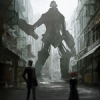Cartoon / filmic / abstract
It seems to me that there are three distinct approaches to video games. 1. The filmic approach, make every thing as detailed as possible and try to convince the player of the reality of the situation by making it look and sound "real". Half-Life 2, etc. 2. The cartoon, less detailed doesn't try to fill in all the blanks allows the player to interpret expressions and imagine. SNES era RPGs. 3. Abstract. Doesn't try to convince that it is real (minesweeper, tetris, etc)
September 12, 2005 12:44 PM
Quote:
Original post by Ketchaval
It seems to me that there are three distinct approaches to video games.
1. The filmic approach, make every thing as detailed as possible and try to convince the player of the reality of the situation by making it look and sound "real". Half-Life 2, etc.
2. The cartoon, less detailed doesn't try to fill in all the blanks allows the player to interpret expressions and imagine. SNES era RPGs.
3. Abstract. Doesn't try to convince that it is real (minesweeper, tetris, etc)
It seems to me that there are three distinct approaches to video game critiques.
1. It was so realistic!
2. Would've been better if it were more realistic.
3. Games should have moved beyond that by now.
These are good categories to start, but where would a game like Tron 2.0 (realistic presentation, less detailed almost abstract world depiction) fall?
What about games that have iconic representations, such as 4X games? Are those abstract? They don't try to convince the player that they're looking at a real starfield or planet, for instance, but they definitely aren't minesweeper.
What about games that have iconic representations, such as 4X games? Are those abstract? They don't try to convince the player that they're looking at a real starfield or planet, for instance, but they definitely aren't minesweeper.
--------------------Just waiting for the mothership...
Games are tricky. They have visual presentations, so you can use a lot of the rules for that sort of thing (Read an old book called "Understanding Comics" by Scott McCloud for a really easy to understand primer to visual communication), but there's also the gameplay element. Even in photoreal games, there are conventions players accept.
Like the "floating object phenomenon when you pick something up in HL2. Players rarely complain that nobody had realistically modelled hands for that. And who was really delighted when Halo 2 showed you the Master Chief's feet? It doesn't matter.
In The Sims 2, the sims actually move the pieces and play games of chess. It's amazing to behold, but after a few hours of play, you know it's a spreadsheet, and you're okay with that.
Not even the most perfect representation of a world can hide the mechanics of play. I'll never forget the scene in Full Spectrum Warrior where I'm being given orders under fire by an impressively modelled officer to take a specialist and disarm some missiles. "Bring the Sargeant with you,*explosion* he'll know what to do! *Machinegun fire*When you get to the Stingers, have him disable the detonators. *ricochet* You remember how to command a specialist, right? Just hold down the "switch teams" button! *shower of masonry* Get out there!"
WIld.
Like the "floating object phenomenon when you pick something up in HL2. Players rarely complain that nobody had realistically modelled hands for that. And who was really delighted when Halo 2 showed you the Master Chief's feet? It doesn't matter.
In The Sims 2, the sims actually move the pieces and play games of chess. It's amazing to behold, but after a few hours of play, you know it's a spreadsheet, and you're okay with that.
Not even the most perfect representation of a world can hide the mechanics of play. I'll never forget the scene in Full Spectrum Warrior where I'm being given orders under fire by an impressively modelled officer to take a specialist and disarm some missiles. "Bring the Sargeant with you,*explosion* he'll know what to do! *Machinegun fire*When you get to the Stingers, have him disable the detonators. *ricochet* You remember how to command a specialist, right? Just hold down the "switch teams" button! *shower of masonry* Get out there!"
WIld.
grrrrr... My first post here! This whole realism bit is something that's been chafing me since Doom 3.
I guess it all is relative to opinion, but I wouldn't call it an approach, I'd call it a strategy. All these strategies should have a clear purpose that correlates to the gameplay, and not simply to showcase how much money your studio has, or how cool your new graphics engine is.... or because it's trendy.
Each of these strategies has a purpose, and I personally think all of them need to be used in a certain balance.
I don't think the goal of a video game should be to make it as real as possible, real life sucks. ;) There always needs to be a balance of simplicity and abstraction along with realism. Abstraction is the real brilliance of first person shooters.
By abstracting the main character into nothing but a view of a gun, immersion is almost total. This is a strategy that comic writers and some film makers have been using for decades. If you haven't ever noticed, think about why in comics characters are drawn as super simple shapes often with no eyes or distinctive features... often that abstraction isn't mirrored in the environment they're drawn on. Calvin and Hobbes is the best example I can think of at the moment.
http://homepage.ntlworld.com/tim.lambert/calvin_and_hobbes.jpg
Look at the awesome realism of the play-house portion when compared to how he normally draws his characters. The abstraction of the characters allows easier immersion, and an easier feeling of relation to the characters. How often did you play Half-Life and feel like you were trying to save Gordon Freeman, instead of saving yourself.
Doom 3 and F.E.A.R., are examples of games being a little -too- realistic. Sure it's an achievement that they look so real... but it's still fake. And it wasn't very fun for me. It's not that the realism was too scary, or too intense... it just kept me out. The gameplay suffered from the realism, it was so slow, so hard to see, so difficult to react to things. It just felt like a grind.
Personally, a cartoony approach is what I favor most. Duke Nukem 3D.(*drool*), Unreal tournaments, Warhammer 40k:Dawn of War, the WarCrafts, and WoW all use cartoony qualities to enhance the fun factor while -all- being gorgeous(for their time). Even Half-life had a cartoony edge that made me fall in love with it.
I'd love to see a new 2D game crash the scene. Sprites were awesome, and with today's technology, I think they'd either find a better way to do it... or they'd make them look just plain awesome.
I guess it all is relative to opinion, but I wouldn't call it an approach, I'd call it a strategy. All these strategies should have a clear purpose that correlates to the gameplay, and not simply to showcase how much money your studio has, or how cool your new graphics engine is.... or because it's trendy.
Each of these strategies has a purpose, and I personally think all of them need to be used in a certain balance.
I don't think the goal of a video game should be to make it as real as possible, real life sucks. ;) There always needs to be a balance of simplicity and abstraction along with realism. Abstraction is the real brilliance of first person shooters.
By abstracting the main character into nothing but a view of a gun, immersion is almost total. This is a strategy that comic writers and some film makers have been using for decades. If you haven't ever noticed, think about why in comics characters are drawn as super simple shapes often with no eyes or distinctive features... often that abstraction isn't mirrored in the environment they're drawn on. Calvin and Hobbes is the best example I can think of at the moment.
http://homepage.ntlworld.com/tim.lambert/calvin_and_hobbes.jpg
Look at the awesome realism of the play-house portion when compared to how he normally draws his characters. The abstraction of the characters allows easier immersion, and an easier feeling of relation to the characters. How often did you play Half-Life and feel like you were trying to save Gordon Freeman, instead of saving yourself.
Doom 3 and F.E.A.R., are examples of games being a little -too- realistic. Sure it's an achievement that they look so real... but it's still fake. And it wasn't very fun for me. It's not that the realism was too scary, or too intense... it just kept me out. The gameplay suffered from the realism, it was so slow, so hard to see, so difficult to react to things. It just felt like a grind.
Personally, a cartoony approach is what I favor most. Duke Nukem 3D.(*drool*), Unreal tournaments, Warhammer 40k:Dawn of War, the WarCrafts, and WoW all use cartoony qualities to enhance the fun factor while -all- being gorgeous(for their time). Even Half-life had a cartoony edge that made me fall in love with it.
I'd love to see a new 2D game crash the scene. Sprites were awesome, and with today's technology, I think they'd either find a better way to do it... or they'd make them look just plain awesome.
grrrrr....grrrrrGGRRARRR!!!
Quote:
Original post by Iron Chef Carnage
Games are tricky. They have visual presentations, so you can use a lot of the rules for that sort of thing (Read an old book called "Understanding Comics" by Scott McCloud for a really easy to understand primer to visual communication), but there's also the gameplay element. Even in photoreal games, there are conventions players accept.
hahahahaha Beat me to it. I guess you can tell that I've read it. ;)
grrrrr....grrrrrGGRRARRR!!!
This topic is closed to new replies.
Advertisement
Popular Topics
Advertisement
Recommended Tutorials
Advertisement








